Clifford Garstang's Blog, page 14
December 21, 2022
2023 Literary Magazine Ranking — Nonfiction

Below is the 2023 Literary Magazine Ranking for Nonfiction. To understand the Rationale, Methodology, and Calculation for the Rankings, please go here.
Note that every effort has been made to verify the website links, but magazines do sometimes change their web addresses and occasionally you will encounter a broken or incorrect link. If that happens, please let me know by emailing info@cliffordgarstang.com.
If you find these rankings useful, please consider supporting this website by making a or by purchasing one or more of my books.
2023 Literary Magazine Ranking for Nonfiction
Note the following:
© means that the magazine/press is closed
(H) means that the magazine/press is on hiatus
(?) means that it’s unclear what’s going on with the magazine/press
2023 RankMagazine2022 Rank2023 Score1Sun1522Georgia Review2483Granta434.54Orion333.55Ploughshares524.56Salmagundi723.57Creative Nonfiction6238Agni1022.59Narrative1421.510Fourth Genre1120.511River Teeth182012Threepenny Review1119.512Tin House ©719.514n+191915New England Review151816Virginia Quarterly Review131717Sewanee Review281518Kenyon Review231418Point, The161420Gettysburg Review1712.521Oxford American2311.522Pinch251123Brevity1910.523New Letters1910.523Paris Review2710.526American Scholar191027Yale Review509.528Ecotone25929Iowa Review298.530Longreads30731Antioch Review (H)196.531Conjunctions326.531McSweeney’s306.534About Place Journal40634Bennington Review35634Caught by the River95634Consequence35634Emergence Magazine35634Reed Magazine95634Terrain.org35641Colorado Review405.541Hudson Review505.541True Story355.544Harvard Advocate40544Bat City40544Chicago Quarterly Review547Boulevard454.547Missouri Review324.549Believer46449Hedgehog Review46449World Literature Today40452Blackbird503.552Ninth Letter503.552Raritan603.552Ruminate503.552Southampton Review323.557Another Chicago Magazine73357Common Reader95357Electric Literature73357Hunger Mountain57357Image46357Southern Review46357War, Literature and The Arts50364American Circus ©602.564Common, The602.564Fourth River602.564Gigantic (?)602.564New Orleans Review602.564Prairie Schooner732.564Radio Silence602.564TriQuarterly602.564ZYZZYVA602.573Alaska Quarterly Review50273Arrowsmith95273Big Roundtable (?)60273Boston Review73273Broad Street73273Crazyhorse73273Guernica57273Gulf Coast95273Michigan Quarterly Review95273Mississippi Review273Normal School57273Pleiades73273Water-Stone Review95286Baffler831.586Bomb1431.586Brick831.586Catapult831.586Chautauqua831.586Hopkins Review731.586Massachusetts Review601.586Willow Springs831.586Witness731.595A Public Space95195American Athenaeum (?)95195Baltimore Review95195Bellevue Literary Review83195Black Warrior Review95195Brain, Child ©83195Briar Cliff Review195Chattahoochee Review95195Cincinnati Review95195Columbia Journal95195Copper Nickel95195Crab Orchard Review (?)95195Denver Quarterly95195Harvard Review95195High Desert Journal83195Hong Kong Review95195Kitchen Work95195Manoa95195Milkweed Editions – Press95195Mount Hope83195New Rivers Press95195Nowhere Magazine95195O-Dark-Thirty95195Offing73195Pacific Standard95195Passages North95195Pen America95195Pidgeonholes95195Potomac Review95195Prism95195Red Hen Press95195Redivider95195Room95195Rumpus195Southwest Review83195Speak95195StoryQuarterly95195Sweet95195Tahoma Literary Review95195Third Coast95195Transition95195Turtle Point Press95195War Horse95195West Branch95195Southern Indiana Review195Blast195Book Post195Brink1143Chicago Review1430.5143American Chordata1430.5143Arts Fuse1430.5143Barrelhouse950.5143Bookforum1430.5143Camera Obscura (?)1430.5143Catamaran1430.5143Dart Society1430.5143Delmarva Review1430.5143Diagram1430.5143Epiphany950.5143Epoch1430.5143Fifth Wednesday ©1430.5143Five Chapters ©1430.5143Five Points830.5143Heyday Books1430.5143Hub City Press1430.5143Lapham’s Quarterly1430.5143Los Angeles Review830.5143Memoir ©1430.5143Natural Bridge1430.5143New Ohio Review1430.5143North American Review1430.5143Oregon Humanities1430.5143Provincetown Arts1430.5143Santa Monica Review950.5143Shenandoah1430.5143Slice950.5143Subtropics1430.5143Tavern Books1430.5143Tikkun1430.5143Timberline Review1430.5143Tupelo Press1430.5143Under the Sun1430.5143Wilson Quarterly1430.5143Zone 31430.5December 20, 2022
2023 Literary Magazine Ranking — Fiction

Below is the 2023 Literary Magazine Ranking for Fiction. To understand the Rationale, Methodology, and Calculation for the Rankings, please go here.
Note that every effort has been made to verify the website links, but magazines do sometimes change their web addresses and occasionally you will encounter a broken or incorrect link. If that happens, please let me know by emailing info@cliffordgarstang.com.
If you find these rankings useful, please consider supporting this website by making a or by purchasing one or more of my books.
2023 Literary Magazine Ranking for Fiction
Note the following:
© means that the magazine/press is closed
(H) means that the magazine/press is on hiatus
(?) means that it’s unclear what’s going on with the magazine/press
2023 RankMagazine2022 Rank2023 Score1Paris Review1612Ploughshares2573Conjunctions3484One Story443.55Zoetrope: All Story640.56Narrative10377Noon8358Southern Review5349Threepenny Review93210Sun153011Missouri Review1028.512Gettysburg Review72813McSweeney’s142613Tin House ©132615American Short Fiction1725.516New England Review122517Idaho Review352417Yale Review322419Kenyon Review1523.520Cincinnati Review2622.520Iowa Review2522.522Granta1821.523Sewanee Review302124ZYZZYVA2219.525Ecotone Magazine201926Glimmer Train ©221827Bellevue Literary Review271727Virginia Quarterly Review181729Agni2116.529Wigleaf2916.531Georgia Review2715.532Santa Monica Review321533New Orleans Review4613.534Copper Nickel3512.535A Public Space241235Hudson Review311237Image341037New Letters421037Pleiades391037Southampton Review421041Epoch389.542Oxford American37942Story53944Bennington Review448.545Common, The46845n+151845Pinch46848Mississippi Review547.548Boulevard397.548Chicago Quarterly547.548Colorado Review397.548Harvard Review507.553Crazyhorse44753Witness51755Catapult545.555Post Road1765.555Raritan575.558Egress ©59558Electric Literature46558Harvard Advocate59558Hysterical Rag ©59558Paper Darts (H)59558Prime Number Magazine59558Southern Indiana Review59558Fractured Lit558Leapfrog Press567Bomb744.567Five Points594.567Ninth Letter594.570Michigan Quarterly Review57470Prairie Schooner74472Epiphany693.572Notre Dame Review693.572Ruminate813.572Southwest Review693.576Alaska Quarterly Review69376Juked78376New Madrid (H)74376Shenandoah88380Antioch Review (H)742.580Consequence Magazine812.580New Ohio Review782.580One Teen Story812.580River Styx812.580Salmagundi812.580Sarabande Books592.580Stillhouse Press592.580West Branch592.589Arts & Letters78289Black Warrior Review88289Blackbird88289Grist88289Third Coast81289Zone 388289Terrain296American Scholar881.596BkMk Press981.596Brick981.596Brooklyn Rail981.596Catamaran981.596Chattahoochee Review981.596Chicago Review981.596Cleaver981.596Fiction1761.596Green Mountains Review981.596Hopkins Review881.596Joyland1761.596Minnesota Review981.596Pembroke Magazine981.596Puerto del Sol1761.596Rupture, The (fka The Collagist)981.596StoryQuarterly981.5113About Place Journal1171113Another Chicago Magazine1171113Autumn House Press1171113Baffler, The1171113Bat City1171113Berkeley Fiction Review1171113Black Clock ©1171113Black Lawrence Press1171113Blue Fountain (?)1171113Broadkill Review1171113Cimarron Review981113Crab Orchard Review (?)1171113December1171113Exile1171113Grand Journal1171113Gulf Coast881113Healing Muse881113Indiana Review981113J Journal691113Jewish Fiction1171113Kweli981113Lake Effect1171113Laurel Review1113Leaf Litter1171113Literal Latte (H)1171113Litmag1171113Little Star881113Massachusetts Review1761113Meridian1171113New Delta Review1171113Nimrod1171113Orion1171113Outlook Springs1171113Per Contra981113Potomac Review1171113Prism1171113Pulp Literature1171113Quarterly West1171113Quiddity1171113Redivider1171113Reed Magazine1171113Reservoir Journal (?)1171113Rumpus1171113Salamander1171113Salt Hill1171113Shade Mountain Press1171113Upstreet981113Vassar Review1171113Water-Stone Review1171113Western Humanities Review1171113Willow Springs981113Worcester Review1171113Woven Tale Press1171113FC21113Greensboro Review1113Scoundrel Time1169African American Review1170.5169Akashic Books1170.5169Asian American Literary Review1760.5169Austin State University Press1760.5169Baltimore Review1760.5169Barrelhouse1760.5169Beloit Fiction1760.5169Broadkill River Press1170.5169Chapter House (fka Mud City)1760.5169Chautauqua1170.5169Cola (fkaYemassee)1170.5169Confrontation1170.5169Crab Creek Review1760.5169Cutbank1760.5169Dalkey Archive Press1760.5169Dr. T.J. Eckleburg Review1760.5169East (?)1170.5169Elm Leaves/ELJ (?)1760.5169Enizagam (?)1760.5169failbetter.com1170.5169Fiction International980.5169Fifth Wednesday ©1170.5169Fjords1760.5169Four Way Books1760.5169Fourteen Hills1760.5169Gascony Writers Anthology (?)1170.5169Gigantic (?)1760.5169Glossolalia1170.5169Graywolf Press1170.5169Hunger Mountain1170.5169John Daniel & Co. (?)1760.5169Literary Review1170.5169Little Fiction (H)1760.5169Lumina (?)1760.5169Malahat Review1760.5169Memorious1760.5169Mid American Review1760.5169Midwestern Gothic ©1760.5169Moon City1170.5169Mythium ©1760.5169Natural Bridge1760.5169Normal School1760.5169North Carolina Literary Review1760.5169Obsidian1170.5169Outpost 191760.5169Pear Noir ©1760.5169Press 531760.5169Provincetown Arts1170.5169Seneca Review1760.5169Sixfold1760.5169Sonora Review1760.5169Spectacle1170.5169Texas Review Press1760.5169Transition1760.5169Tweed’s (?)1760.5169World Literature Today1760.5December 19, 2022
2023 Literary Magazine Rankings: Overview

It is time once again for the annual Literary Magazine Rankings for Fiction, Nonfiction, and Poetry. As explained in more detail below, these rankings are based solely on the number of Pushcart Prizes and Pushcart Special Mentions the magazines have received over the past ten-year period. They are intended as a guide for determining where writers might submit their work for publication.
If you find these rankings useful, please consider supporting this website by making a or by purchasing one or more of my books.
2023 Literary Magazine Ranking for Fiction [link will be live on or before Tuesday, Dec. 20]
2023 Literary Magazine Ranking for Nonfiction [link will be live on or before Wednesday, Dec. 21]
2023 Literary Magazine Ranking for Poetry [link will be live on or before Thursday, Dec. 22]
Rationale. When I first started submitting my short stories to literary magazines, I didn’t know what I was doing. I was aware that some magazines were more prestigious than others, but I didn’t have a way of evaluating prestige. I subscribed to several (and still do) but choosing where to submit my work was often hit-or-miss until I started tiering. I didn’t invent the idea of tiering submissions, but when I learned of it, I thought it made great sense for me.
Tiering is an aid to simultaneous submissions that groups the best magazines together in the top tier, somewhat less prestigious magazines in the next tier, and so on. It is advisable to submit work to the top tier first, or at any rate within the same tier, so that an acceptance by one, which requires withdrawal from the others, won’t be painful. (If you get an acceptance from a lower-tier magazine while you’re still waiting to hear from a higher-tier magazine, that could lead to a difficult withdrawal. Withdrawal is ethically required, but what if the higher-tier magazine was about to accept the piece?) So, I decided to rank literary magazines—first in fiction, because that’s what I was writing, but later in poetry and nonfiction because many people requested that—to help me decide where to submit. In theory, I would aim toward the top of the list and work my way down until someone finally accepted my story.
Methodology. To create the rankings, I considered looking at the various annual anthologies (Best American Short Stories, O. Henry, and Pushcart) to see what the editors of those volumes considered the best magazines to be. Ultimately, for several reasons, I settled on using only the annual Pushcart Prize anthology. For one thing, it excluded the “slicks”—magazines like The New Yorker, Atlantic Monthly, and Harpers—whose prestige is well-known. Those markets are really in a category by themselves, and writers should definitely submit to them if they deem their work suitable for publication in these elite magazines. For another, consideration for inclusion in the Pushcart Prize anthology seemed somewhat more democratic, or at least transparent, than the other options. Although there are Editors-at-Large who nominate for the anthology, every magazine has the opportunity to do so as well, so the Pushcart editors see thousands of entries and can pick from work that has appeared in hundreds of different journals, both in print and online. Finally, when I began ranking poetry and nonfiction magazines, too, it was fortuitous that the Pushcart Prize anthology includes those genres. Otherwise, I’d have had to look at separate volumes for each genre and I still preferred the relative fairness of the Pushcart approach. It should be noted that the Pushcart editors have been slow to recognize the quality of online literature, but that has been changing, and quite a few of the honored pieces were first published only in digital form.
Calculations. I decided from the beginning to use a ten-year rolling formula to determine the rankings. It seemed to me that reputations aren’t won or lost in one year, and that the best magazines, the markets where I’d really like to be published, are the ones that have been around awhile and have really established themselves. So, I created a formula that used a fixed-point value for each Pushcart Prize won in each of the ten years and a smaller number of points for each special mention (those are the stories listed at the back of the book as also being worthy of note). The formula adds up all the points and ranks the magazines based on the total. (The total number of points is shown in the far-right column of the ranking.) Several years ago, I adjusted the formula so that prizes and special mentions earned in the last five years are weighted more heavily than those from the first five years of the period. The intention of this adjustment was to recognize the fact that in the digital age, magazines may emerge and be deserving of accolades more quickly than was the case in the past. So, a Pushcart Prize won today gets more points than one earned five years ago. Note, too, that the rankings are as objective as I can make them. The editors of the nominating journals and of the Pushcart Press are exercising their judgment, of course, but I’m just going by the numbers. My rankings don’t take into account how much the magazines pay, or whether they charge for submissions, or how long it takes them to respond. Different writers feel differently about those factors, and so I don’t want to impose my judgment in place of theirs. For a different ranking approach, check out Erika Krause’s Rankings.
Frequently Asked Questions
XYZ Magazine is Closed, so why is it included in the rankings? When I am certain that a magazine has closed, I will include the symbol © next to its name. I think it’s useful for historical purposes to note that, for example, Tin House, was a fine magazine until it shut its doors. Also, some closed magazines still have their archives online or other useful information, so I’ve included links to their websites, even though they’re no longer open for submissions.
What do the other symbols mean? Quite a few magazines decide to take a break from publishing (the pandemic seems to have had that effect on several) but not to shut down entirely. They may say that they are on pause or on hiatus. When I know about it, I’ll mark the magazine with (H). Other magazines have broken website links or websites that haven’t been updated in some time, suggesting that they may have closed. But if don’t know that for sure, I don’t want to declare their death prematurely, so I’ll mark the entry with (?).
It’s a ranking of literary magazines, so why are there some small presses included? Good question. Technically, the Pushcart Prize recognizes the “best of the small presses,” and so stories, essays, or poems published in collections from independent presses frequently win prizes or special mentions, landing them in the mix for the rankings. I think it’s useful to include them in order to draw them to the attention of writers who may be looking for places to submit whole collections.
This endeavor seems like a lot of work. What do you get out of it? As I noted above, I created the first rankings many years ago when I needed guidance on where to submit work. When I started sharing the rankings, the feedback I heard from many people was that the rankings were very useful. I’m happy to provide this service and if people want to make a donation (or buy one or more of my books) to support it, that’s much appreciated.
December 18, 2022
The Rankings are Coming, the Rankings are Coming!

Later than originally expected (but earlier than I thought after receiving a notice that the annual Pushcart Prize anthology would not arrive until mid-January), the 2023 Literary Magazine Rankings will be published here this week.
On Monday we’ll start with the overview, a page that explains the rationale behind the rankings as well as my methodology. New this year will be an FAQ section, which some readers may find helpful.
On Tuesday, I’ll post the Fiction Ranking, on Wednesday the Nonfiction Ranking, and on Thursday the Poetry Ranking will go up.
I hope the Rankings may be of some use to you.
December 7, 2022
A Return to Europe: Vienna and Budapest
A few years ago, I resolved to do more international travel. I had the means and the opportunity, so why not? In 2017 I spent several weeks in Southeast Asia (research for my recently completed book). In 2018 I spent six weeks in France (including a writing retreat at VCCA France). In 2019 I made two trips to Europe: one to Prague in late summer (hot!) and one to Barcelona in late fall (perfect!). I was looking forward to making at least one trip abroad per year, but then came 2020 and the Global Pandemic.
Fortunately, things began to change in 2022. Though fully vaccinated, I came down with Covid in the summer. Then I got the latest, Omicron-specific, booster, and I decided I was comfortable with the idea of flying again. But where should I go?
There are so many places I haven’t visited yet. And there are many places I’d love to return to. When I was in Prague in 2019, several people I met were planning to cruise down the Danube to visit other Central European cities such as Vienna, Bratislava, and Budapest. Since I didn’t manage to see those cities on that trip, they were high on my list. So, when?
My thinking on the timing may seem a little random, but there’s a young Canadian classical pianist whose work I have been following since I discovered him on YouTube a year or so ago. (Jan Lisiecki–check him out.) He was a child prodigy (a descriptor no former child prodigy likes, I suspect) and is still only in his 20s, but records and performs extensively all over the world. In interviews, he seems completely charming and grounded. I happened to look up his tour schedule and he was going to be performing with the Vienna Symphony in November, on dates in the window for travel that was open to me. That seemed reason enough to make my decision, so I began setting up the trip.
A friend got wind of my travel plans and offered to meet with me to share his experiences in the region, and that was very helpful. I picked up the Rick Steves guidebooks for both Vienna and Budapest, and made a list of the must-see sites.
Booked: flights to and from Vienna, train to and from Budapest, AirBnB accommodations, various tours and experiences in each city, a day trip to Bratislava, and, importantly, a ticket to the Vienna Symphony concert.
Everything worked pretty much according to plan. I went to countless museums, ate and drank a lot, and generally wore out my shoes walking around each city and generally exhausted myself being a tourist. Plus, the concert was great, and I got to have a very brief conversation with Lisiecki. (I’m listening to his recording of the Chopin Nocturnes as I write this.)
I should mention the literary side of the journey. In Vienna, there is a wonderful English-language bookstore, Shakespeare & Co., and I visited there to pick up some European reading material. I bought two books by Annie Ernaux, one of which I read immediately, and one by Austrian Thomas Bernhard. In Budapest, the English language store BestSellers was recommended to me and there I bought books by two Hungarian writers, Laszlo Krasznahorkai and Jeno Rejto. (The bookseller was impressed that I had already read one of his other recommendations, The Book of Fathers by Miklos Vamos.) I carried with me on the trip another novel, by American writer Arthur Phillips, which is set in Budapest (though confusingly titled Prague). Still working my way through that one. (One more note here: other than the books I bought and the pictures I took, my only souvenirs from the trip are two kinds of Hungarian paprika.)
So, mission accomplished, and I can begin planning my next trip. Where to?
 St. Istvan Basilica Budapest
St. Istvan Basilica Budapest
 Duck — Stadtpark Vienna
Duck — Stadtpark Vienna
 Shoe Memorial Budapest
Shoe Memorial Budapest
 Vienna Christmas Market
Vienna Christmas Market
 Budapest House of Terror
Budapest House of Terror
 Vienna Musikverein
Vienna Musikverein
 Vienna Secession
Vienna Secession
 Vienna Schonbrun Palace
Vienna Schonbrun Palace
 Vienna Opera House
Vienna Opera House
 St. Stephans Cathedral Vienna
St. Stephans Cathedral Vienna
 Budapest Opera House Side
Budapest Opera House Side
 Upper Belvedere Palace Vienna
Upper Belvedere Palace Vienna
 Budapest Opera House
Budapest Opera House
 Fritz Winery Hungary
Fritz Winery Hungary
 KarlsKirche
KarlsKirche
 Grand Synagogue Budapest
Grand Synagogue Budapest
 Budapest Parliament
Budapest Parliament
 Holocaust Memorial Bratislava
Holocaust Memorial Bratislava
 Budapest Parliament from Buda
Budapest Parliament from Buda
 Prantner Winery Cellar
Prantner Winery Cellar
 Bratislava Castle
Bratislava Castle
 Bratislava
Bratislava
December 5, 2022
I’ve Got Questions for Culley Holderfield
Editor’s Note: This exchange is part of a series of brief interviews with emerging writers of recent or forthcoming books. If you enjoyed it, please visit other interviews in the I’ve Got Questions feature.
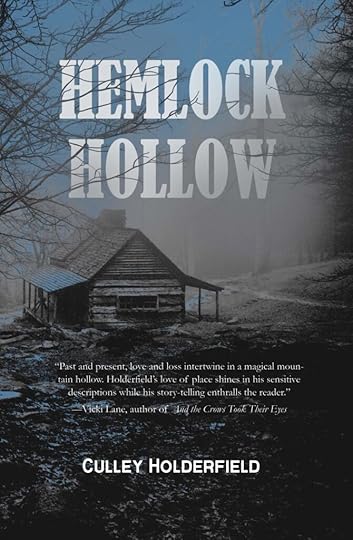 Hemlock Hollow by Culley HolderfieldWhat’s the title of your book? Fiction? Nonfiction? Poetry? Who is the publisher and what’s the publication date?
Hemlock Hollow by Culley HolderfieldWhat’s the title of your book? Fiction? Nonfiction? Poetry? Who is the publisher and what’s the publication date?Hemlock Hollow
Fiction
Regal House Publishing (December 6, 2022)
In a couple of sentences, what’s the book about?When an archaeologist inherits a cabin in an Appalachian hollow, she discovers a boy’s journal that lures her into the depths of a century-old murder and forces her to face down a past she has long tried to escape.
What’s the book’s genre (for fiction and nonfiction) or primary style (for poetry)?Historical mystery, Southern fiction
What’s the nicest thing anyone has said about the book so far?That’s a hard question. One reviewer compared it to The Color Purple, and others have compared it to Barbara Kingsolver’s work. A comparison to either would be astonishing and overstated, but to be compared to both really makes my day because Alice Walker and Barbara Kingsolver are two of my absolute favorite writers.
What book or books is yours comparable to or a cross between? [Is your book like Moby Dick or maybe it’s more like Frankenstein meets Peter Pan?]It’s a historical novel set in the mountains of North Carolina, rife with secrets and family history with a dual-timeline braided narrative that takes the reader on a journey of discovery. For some, it might evoke Sharyn McCrumb’s The Unquiet Grave or Lee Smith’s On Agate Hill. One reader described it as Cold Mountain meets Fried Green Tomatoes.
Why this book? Why now?Hemlock Hollow was inspired by a cabin in Henderson County that my parents bought in the 1970s that became the setting of my childhood summers. I was fascinated by the prior occupants of the place and set out to figure out who they were and what kinds of lives they led. Eventually, that research would lead me to write this novel. I worked on it off and on for years, revising, rinsing, repeating. Seven or eight drafts later, I finally got it where I wanted it. Writing this novel was my own journey into the past and is my own way of making sense of my relationship to a specific place that influenced my life profoundly.
Other than writing this book, what’s the best job you’ve ever had?I’ve been lucky to have a day job that compensates me for doing challenging, meaningful work in the world. I’ve worked for 20 years at a community development credit union in Durham, NC and have loved it. But the best job I’ve ever had has to be the job I worked in college when I was at UNC-Chapel Hill, which was cataloging incoming materials in the Southern Historical Collection. Getting to work firsthand with historical documents was eye-opening and provided a more intimate relationship with history than any textbook. For example, I got to handle (very carefully) the correspondence of Marion Butler, agrarian reformer and architect of the Fusionist government in North Carolina and, later, the college transcripts of Senator Sam Ervin of Watergate fame. I made less than $4 per hour there, but I wouldn’t trade that experience for all the money in the world. That job gave me the skills I’ve used in researching this and other novels.
What do you want readers to take away from the book?Primarily I hope they derive some enjoyment from reading it. Beyond that, I hope that maybe it causes readers to reflect on their own relationships with special places in their lives, whether those are of the natural world or human-made.
What food and/or music do you associate with the book?Food for consumption appears in the book, but it isn’t central to the theme or plot.
But the production of food is quite important. Carson’s father owns a grist mill, and Carson spends many hours tending to it, feeding hominy and corn into the hopper, bagging up cornmeal and grits, helping to troubleshoot breakdowns. It’s there that he learns the value of hard work and absorbs his father’s stoic expectations.
The Quinn family also lives close to the old Drovers’ Road that passed through the Hickory Nut Gap (now US Hwy 74), which would team with livestock after harvest season as farmers drove their hogs, cattle, turkeys, and hens from the mountains to markets to the south and east. At the time of Carson Quinn’s journal in the 1880s, both milling hominy and driving livestock are becoming things of the past. Industrialization has begun to change people’s relationship to the land and food, and that’s one of the tensions in the novel. Of course, there’s also moonshine, also rife with tension, should you consider it food.
As for music, it’s present in the background, from the plaintive yearning of ballads like Lorena in Carson’s era to the raucous chords of Slayer in Caroline’s time, with a bit of fiddling and banjo playing in between.
What book(s) are you reading currently?Less than a month ago, North Carolina lost a treasure when Philip Gerard passed away unexpectedly. He chronicled North Carolina history both with his fiction and non-fiction, including his novel about the 1898 Wilmington coup entitled Cape Fear Rising. Right now, I’m reading his Civil War history of North Carolina published by UNC press called The Last Battleground.
In fiction, I’m reading Scott Blackburn’s novel It Dies with You, a gritty Southern noir set in the North Carolina Triad region, another novel about family secrets unearthed unexpectedly.
 Culley Holderfield
Culley HolderfieldLearn more about Culley on his website.
Follow him on Twitter and Instagram.
Buy the book from the publisher (Regal House Publishing) or Bookshop.org.
December 1, 2022
2022 Reading — November
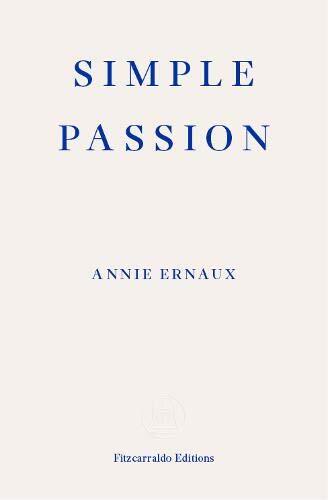 Simple Passion by Annie Ernaux
Simple Passion by Annie ErnauxSimple Passion by Annie Ernaux (translated from French by Tanya Leslie) is a short book that takes a deep dive into the impact passion can have on a life, and most likely I would not have come to this book if the author had not won the Nobel Prize in 2022. The narrator—one assumes the book is fiction, but maybe not—is a French woman who is having an affair with a married man, a foreigner, who is temporarily living in Paris. She is obsessed, although perhaps more with her own passion than with the man. She waits for his phone calls announcing a coming visit, she thinks of him when choosing what to wear, and so on. It’s all about the trysts that may or may not be coming. Eventually, the man returns to his country, as she has known he would, but that doesn’t stop her from thinking of him. I plan to re-read this book (and I’ve picked up another by the author) because the intensity of the narrator’s feeling is worth examining more closely.
 Blooming Fiascoes by Ellen Hagan
Blooming Fiascoes by Ellen HaganBlooming Fiascoes by Ellen Hagan is a collection of poetry published last year by Northwestern University Press, which is how I came to have a copy. I do appreciate poetry, and in these poems I found the subject matter—a fair amount of personal issues and family—to be understandable, but the language off-putting. Instead of sentences, the poems are made up, often, of fragments and sometimes the fragments include words that in juxtaposition don’t seem to make sense. For example: “I feel full-on gravity. Float. Unadjusted./ Unaccustomed. Raid style showoff. Stunted/ & stunting. If I must. Say foundational. Some-/ times I mother gold & the world & you & your/ lost tooth & empty gums. Showoff. I shake/ your accustomed foundations. Foundational.” Those lines are typical of her style and I didn’t care for it. Also, the poems all use the ampersand instead of “and” and I find that annoying. Sorry, poets, I just do.
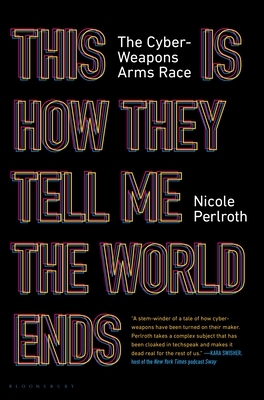 This is How They Tell Me the World Ends by Nicole Perlroth
This is How They Tell Me the World Ends by Nicole PerlrothThis is How They Tell Me the World Ends: The Cyber-Weapons Arms Race by Nicole Perlroth is a detailed account of how vulnerable we all are to internet-based hacking with malicious intent. My book club’s selection for November, the book is scary as hell, telling the story of the offensive use of flaws in computer code that has allowed many players—including the U.S.—to wreak havoc with their adversaries. And because computer viruses spread, it’s nearly impossible to prevent those attacks from coming back to haunt the originator. Besides that, finding the flaws in the first place is huge business, and hackers can sell their finds to the highest bidders, many of whom do not have the public’s interest in mind. The last part of the book deals with the attacks on American election systems perpetrated by Russia and others, much of which we heard about during the 2020 campaign and its aftermath. The Epilogue includes concrete steps that should be taken to secure systems, but unfortunately, these aren’t steps individuals can take. We’re all dependent on governments and companies to do the right thing.
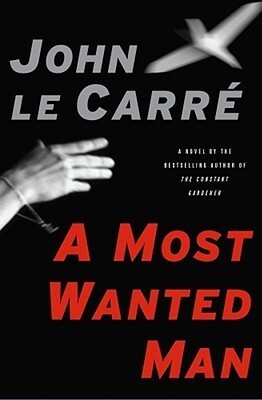 A Most Wanted Man by John Le Carre
A Most Wanted Man by John Le CarreA Most Wanted Man by John Le Carré is a terrific novel by the master published in 2008. The plot is engrossing, the characters full, and the writing is brilliant. Knowing that the author wrote thrillers and spy novels, it isn’t clear at first where this one is going, as we see a Turkish Muslim family in Germany, mother and son, give refuge to a young Chechen refugee. It develops, however, that the refugee is the illegitimate son of a Russian general who was a spy for the British, depositing laundered funds in a Viennese bank that has relocated to Hamburg. He has come, he says, to get the help of the Banker who holds the funds, even though he doesn’t want to touch the money, which he considers sinful. Meanwhile, authorities suspect him of being a terrorist, largely based on the fact that he was in jail in both Chechnya and Turkey.
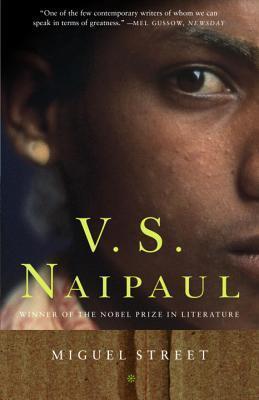 Miguel Street by V.S. Naipaul
Miguel Street by V.S. NaipaulMiguel Street by V.S. Naipaul is a collection of linked stories set in Trinidad published in 1959 that was recommended to me by a new friend when he learned that I had written a novel in stories (What the Zhang Boys Know). I really enjoyed these stories more than anything I’ve read by Naipaul in the past. While I wouldn’t call the book a novel, there is an arc in that we see the narrator grow up on Miguel Street, begin to understand what’s going on around him, and eventually leave Trinidad on a scholarship to study in college. Along the way, he provides portraits of many of the curious characters on the street, their various antics and schemes, and in some cases the tragedies that befall them.
November 28, 2022
Review of OLIVER’S TRAVELS

Book Review from Book Excellence
Oliver’s Travels by Clifford Garstang is a poignant story about the very nature of reality, who we are as human beings—and whether it’s possible to leave the past behind.
Ollie Tucker is fresh out of college and on a quest to discover life’s deeper meaning. Haunted by an unclear memory from his past, Ollie sets out on a path of self-discovery. In the midst of writing a novel, where he portrays himself as a more charming, adventurous version of himself, Ollie convinces his wife to travel the world in search of his presumed-dead Uncle and confront the person he is most afraid of, so that he can finally move on with his life and find peace.
Garstang’s writing is sharp, witty and skilfully captures the intricacies of relationships, as he depicts Ollie’s experience in his marriage, with his family and the ever-elusive Uncle Scotty. Effortlessly, the stage is set and the reader becomes emotionally invested in an entire ensemble of familiar characters. What truly makes this book a standout work of fiction is Ollie. Garstang portrays Ollie as a multifaceted character who has a deeply introspective and philosophical approach to life, and who like most of us, is trying to figure out who he is and who he wants to become.
Overall, Oliver’s Travels is a compelling page-turner that grips readers with its stunning insight into relationships and the impact they have on one’s life. Highly recommended! – Review by Book Excellence (bookexcellence.com)
November 26, 2022
2023 Literary Magazine Rankings — delayed

I have already been asked by one eager writer when the 2023 Literary Magazine Rankings will be posted. Usually, the anthology on which the updated rankings are based arrives in November, but a few weeks ago I learned delivery would be delayed until December. Now I’m told it will be mid-January before the volume gets here. I can’t do the rankings without the latest book–as most people know, the rankings are based on a 10-year record of Pushcart Prizes and Special Mentions–so there’s nothing I can do (other than test the links from 2022 to see which magazines have closed shop or changed the URL of their online presence). So, please stay tuned. The current best guess for when the rankings will be posted is January 18.
November 14, 2022
I’ve Got Questions for Bruce Overby
Editor’s Note: This exchange is part of a series of brief interviews with emerging writers of recent or forthcoming books. If you enjoyed it, please visit other interviews in the I’ve Got Questions feature.
 The Cyclone Release by Bruce OverbyWhat’s the title of your book? Fiction? Nonfiction? Poetry? Who is the publisher and what’s the publication date?
The Cyclone Release by Bruce OverbyWhat’s the title of your book? Fiction? Nonfiction? Poetry? Who is the publisher and what’s the publication date?The Cyclone Release – A Novel of Silicon Valley
Fiction
Madville Publishing, November 15, 2022
It’s the late 90s Internet boom, and Brendon Meagher has just lost his wife Sadie in a freakish car accident at the edge of Silicon Valley. The Cyclone Release follows Brendon as he emerges from tragedy and lands in a pre-IPO start-up that promises astonishing riches. Mo Gramercy, a bright and commanding colleague with her own dark secrets, joins Brendon, disrupts his malaise, and takes him as her lover. The characters careen toward IPO millions, their secrets suddenly converging, and both are shaken without mercy from bucolic notions of work, life, and impending fortune.
What’s the book’s genre (for fiction and nonfiction) or primary style (for poetry)?Upmarket Literary Fiction
What’s the nicest thing anyone has said about the book so far?“Masterful, provocative, and compulsively readable.”
— Danielle Girard, USA Today and Amazon #1 Bestselling Author of Far Gone
What book or books is yours comparable to or a cross between? [Is your book like Moby Dick or maybe it’s more like Frankenstein meets Peter Pan?]Saul Bellow’s Seize the Day at the cusp of the internet age.
Why this book? Why now?The Cyclone Release is a realistic portrayal of a work-obsessed culture and its impact on the human condition. It shifts the focus away from the youthful billionaires we see in the headlines, and toward those who toil at screens and keyboards, even as they face down demons of tragic loss, the need for belonging, and the fear of not measuring up. Right now, in what are hopefully the later stages of the pandemic, the world of work is being transformed in countless ways, a transformation that is largely being driven by Silicon Valley. This is therefore the perfect time for an intimate look behind the cubicle walls of Silicon Valley during a similar period of transformation, the late-90s internet boom.
Other than writing this book, what’s the best job you’ve ever had?This book is loosely based on my years in Silicon Valley startup companies from 1999 to 2002, and my most cherished experience was one I had during that time, when I was about the same age as my protagonist, Brendon Meagher, who is 38. Setting aside the word salad used to describe the specifics of the job, I was essentially a writer, a teacher, and a manager of just a few people. It was difficult and painful, but I grew immeasurably as a person during that time, as I think Brendon does during the hard summer of 1998 depicted in the book.
What do you want readers to take away from the book?I want this book to help readers understand that Silicon Valley is not a business model or a tribe of young billionaires infecting our society as they pack their offshore accounts; it’s a place with a distinct culture and history all its own. It’s a place where regular people toil daily for reasons that are universally human: security, dignity, and a need to belong, to be part of something larger than oneself.
What food and/or music do you associate with the book?In Silicon Valley startups, companies often serve free food in company break rooms: donuts in the mornings and in the evenings, trays of rice, butter chicken, and lamb saag, or refried beans, chili colorado, and chili verde. The Verve’s “Bittersweet Symphony,” with its prescient lyric, blasts from the speakers at the company’s IPO party.
What book(s) are you reading currently?Having just finished Lucy by the Sea by Elizabeth Strout, my favorite American author and former thesis advisor, I am now reading Gravity Hill by fellow Madville Publishing author Susanne Davis. My book won Third Prize in Madville’s Blue Moon Novel Competition, and Gravity Hill won Second Prize, and I not only try to support my fellow lesser-known authors, I find this is a great way to read and recommend some truly remarkable writing that might otherwise go unnoticed.
 Bruce Overby
Bruce OverbyLearn more about Bruce on his website.
Follow Bruce on Facebook, Twitter, Instagram, and YouTube.
Buy the book from the publisher (Madville Publishing), Bookshop.org, Indiebound, Amazon, Barnes & Noble, or Books, Inc.



